Here’s Our Comprehensive Guide on Performing Fixed Asset Verification

Helpful Summary
Overview: This guide emphasizes the importance of fixed asset verification in ensuring the accuracy and reliability of a company's financial data, including tangible assets like machinery and intangible assets like patents.
Why You Can Trust Us: At BlueTally, we offer features like real-time tracking, automated data entry, and efficient reconciliation for efficient fixed asset verification.
Why It Matters: Fixed asset verification is crucial for maintaining transparency, preventing errors, upholding compliance with standards such as the Companies Act 2013, and ensuring accurate financial reporting. It instills trust among investors and regulatory bodies.
Action Points: We suggest creating a comprehensive asset register, categorizing assets, assigning responsibility for asset verification, conducting physical verification, reviewing documentation, and updating the asset register based on findings.
Further Research: To complement this learning, explore the specific regulatory requirements for fixed asset verification in your industry and region and consider the benefits of leveraging technology like IoT systems and asset management software.
Ensuring the accuracy and reliability of financial data is paramount in business management. Fixed assets, comprising tangible assets like machinery and intangible assets like patents, play a crucial role in a company's financial health.
Performing fixed asset verification is essential to maintain transparency, prevent errors, and uphold compliance. It is required by accounting and legal standards, such as the Companies Act, 2013. For smaller organizations, an annual or biennial physical verification may suffice, while larger organizations or those in industries with frequent asset turnover may require more frequent checks
At BlueTally, we understand the importance of fixed asset verification in ensuring accurate records and effective asset management. This comprehensive guide will delve into the intricacies of effectively performing fixed asset verification.
Why Listen to Us?
Fixed asset verification can be daunting. At BlueTally, we've guided many small businesses through this crucial process. Particularly, our platform streamlines and automates asset tracking for accurate audits. This approach not only ensures compliance, but also optimizes operational efficiency, helping businesses maintain accurate financial records and eliminate ghost assets.
Having reliable asset records leads to significant benefits. It improves financial accuracy, enhances operational efficiency, and boosts credibility with investors. Our collaboration with various companies such as Pfizer, Unilever, Vodafone, and more demonstrates our commitment to providing businesses with effective solutions for fixed asset verification, using advanced integrations and security features for seamless management

What is Fixed Asset Verification?
Fixed asset verification is the process of confirming a company's fixed assets' existence, location, and condition. It serves as a safeguard against mismanagement, fraud, and financial discrepancies. Proper verification ensures that the financial statements accurately reflect the organization's assets, giving stakeholders confidence in the company's financial position.
One primary reason for conducting fixed asset verification is to comply with regulatory requirements. Different industries and regions may have specific rules governing the reporting and verification of fixed assets. Staying compliant not only avoids legal complications but also instills trust among investors and regulatory bodies.
Leveraging IoT systems and asset management software like BlueTally can streamline the process. We offer real-time tracking, automated data entry, and efficient reconciliation to enhance the accuracy and efficiency of asset management.
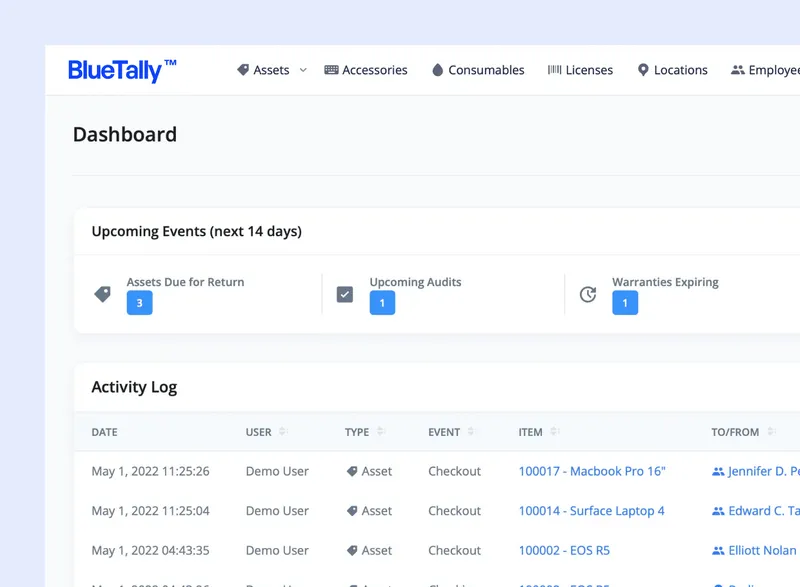
Implementing a fixed asset management system offers numerous benefits, from extending asset lifespans to improving regulatory compliance and decision-making. As such, organizations should consider adopting practices and technologies that support effective asset verification.
Benefits of Fixed Asset Verification
- Regular Monitoring and Tracking of Assets: Fixed asset verification facilitates the regular monitoring and tracking of assets. It helps organizations keep a close tab on their physical assets, condition, and whereabouts.
- Reduction in Theft and Loss: By accurately tagging and verifying assets, companies can significantly reduce instances of theft and misplacement. This ensures that assets remain within the organization and are used effectively.
- Time and Cost Savings: The process helps save time and money by avoiding the duplication of assets, streamlining the inventory process, and ensuring that the financial records accurately reflect the physical state of assets.
- Accurate Financial Reporting: Asset verification ensures that financial reporting is accurate, which is crucial for compliance with financial regulations and standards. This accuracy supports better decision-making and financial planning.
- Efficient Resource Allocation: By knowing the exact status and location of assets, organizations can allocate their resources more efficiently. It helps avoid unnecessary purchases and optimize the use of existing assets.
Steps to Perform Fixed Asset Verification
1. Create an Asset Register
Before initiating the verification process, ensure that your organization maintains a comprehensive asset register. This register should include asset description, acquisition date, cost, depreciation, and current location. A well-maintained register forms the foundation for a successful verification process.
BlueTally allows you to register your fixed assets with a unique asset ID. This ID can be represented as a QR code, which can be scanned to access the asset’s information quickly.
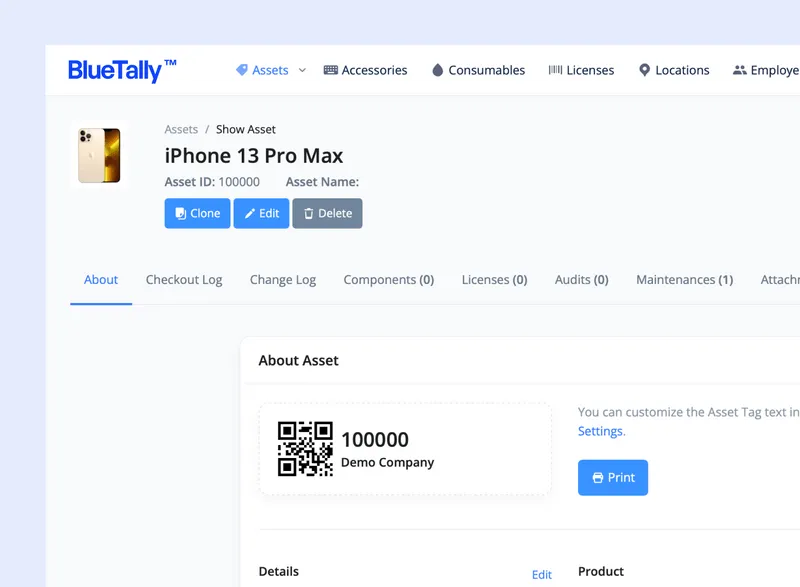
You can record important details such as the asset description, acquisition date, cost, and current location for each asset. You can also add a photo noting the condition of the asset.
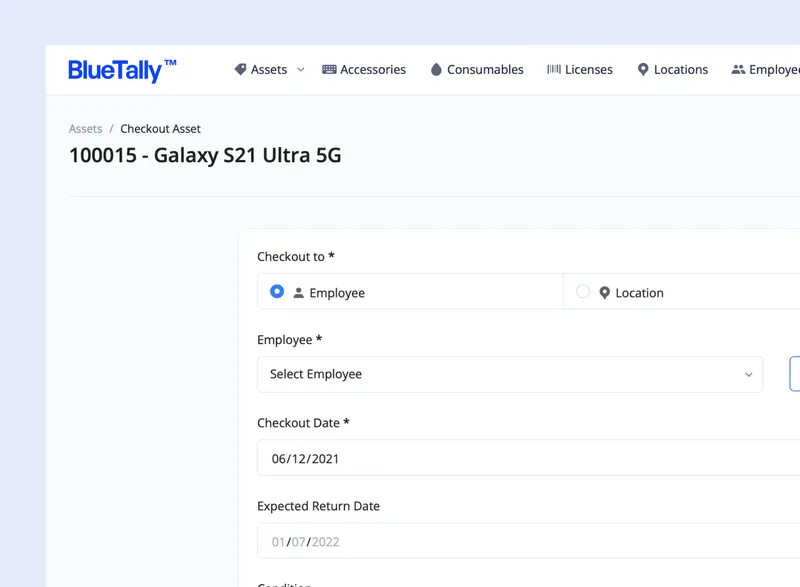
BlueTally can also help track the depreciation of each asset over time, providing a clear picture of the asset’s value.

BlueTally calculates the depreciation of your assets and licenses using the straight-line method. You can view the depreciation for each asset in the asset overview or utilize the Depreciation Report for a comprehensive financial overview of all your assets.
2. Categorize Assets
Segment your fixed assets into categories based on their nature, such as machinery, buildings, or intellectual property. Categorization streamlines the verification process, allowing for a more systematic and organized approach.
In BlueTally, you can create custom categories for your assets. This allows you to group similar assets together, making it easier to manage and track them.
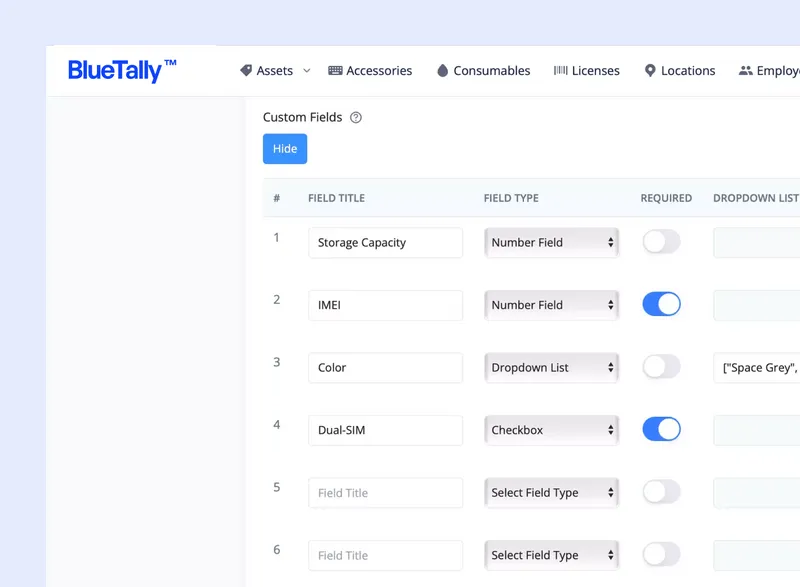
You can filter and sort your assets based on these categories once they are categorized. This can streamline the verification process, allowing for a more systematic and organized approach.
3. Assign Responsibility
Clearly define roles and responsibilities for the verification process. Designate individuals or teams responsible for specific asset categories or locations. This ensures accountability and prevents oversight during the verification process.
BlueTally allows you to set custom permission levels for different users. This means you can designate individuals or teams responsible for specific asset categories or locations and limit their access to only the relevant sections of the asset register.

In BlueTally, you can also checkin your fixed assets to employees or locations. This feature allows you to assign responsibility for specific assets to individuals or teams.
BlueTally also maintains a changelog that allows you to view the entire history of your fixed assets inventory. This can be used to track who changed the asset register, ensuring accountability.
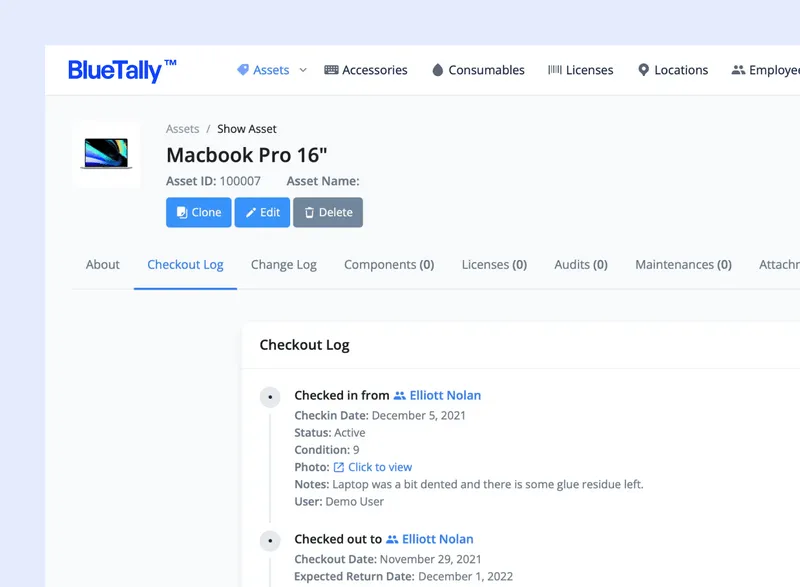
4. Physical Verification
Conduct a physical inspection of each asset to verify its existence, location, and condition. Utilize technology, such as barcode scanners or RFID tags, to streamline the process and minimize errors. Take note of any discrepancies or damages discovered during the physical verification.
As explained earlier, each of your fixed assets can be given a unique QR code with its own asset ID in BlueTally. This can be scanned using a barcode scanner to verify the asset’s existence and location quickly.
BlueTally also allows you to add a score and a photo noting the condition of your assets. This can be used to record the asset's condition during the physical inspection.
Any discrepancies or damages discovered during the physical verification can be noted in BlueTally. This includes changes in the asset’s condition, location, or other details.
5. Documentation Review
Verify supporting documentation, such as purchase invoices, maintenance records, and depreciation schedules. Cross-reference this information with the data in the asset register to ensure accuracy and completeness.
6. Update Asset Register
Update the asset register based on the findings from the physical verification and documentation review. Adjust asset values, depreciation calculations, and any other relevant information to reflect the most accurate and current data.
Investing in asset management software like BlueTally can significantly streamline the fixed asset verification process. Our tool automates data entry, track changes, and provide real-time insights, reducing the likelihood of human error and improving overall efficiency.
Best Practices for Effective Fixed Asset Verification
Regularly update the asset register
The asset register is a crucial document that tracks all fixed assets within an organization. Regular updates ensure the register reflects current asset information, including additions, disposals, transfers, and depreciation.
Assign a responsible team or individual to update the asset register promptly whenever there is a change in the status of a fixed asset. This can include acquisitions, retirements, or any other relevant changes.
Conduct surprise audits
Surprise audits act as a deterrent to potential fraud or inaccuracies in the asset register. They help maintain the integrity of the verification process by catching discrepancies that might otherwise go unnoticed.
Schedule surprise audits at irregular intervals. This could involve selecting a random subset of assets for verification without prior notice. This approach ensures that staff members are consistently vigilant and that potential discrepancies are identified promptly.
Provide comprehensive training to the verification team
A well-trained verification team is essential for accurate and efficient fixed asset verification. Training enhances their understanding of the process, relevant policies, and the importance of attention to detail.
Implement regular training sessions to keep the verification team updated on any changes in procedures, regulations, or technology that may impact their work. Training should cover areas such as asset identification, valuation, and documentation.
Establish a clear communication protocol
Effective communication is vital for addressing and resolving discrepancies identified during the verification process. A clear protocol ensures that all stakeholders are informed promptly, and corrective actions can be taken in a timely manner.
Define a communication protocol that outlines the steps to be taken when a discrepancy is identified. This may include reporting mechanisms, escalation procedures, and a timeline for resolution. Ensure all team members are familiar with the protocol to streamline the process.
Conclusion
Performing fixed asset verification is not merely a regulatory obligation but a strategic initiative to safeguard a company's financial health and reputation. Organizations can streamline the verification process by following a systematic approach, implementing best practices, and instilling stakeholder confidence.
Moreover, leveraging asset management software like BlueTally can automate data collection, streamline reporting, and provide real-time insights into asset status and depreciation. This level of automation not only saves time but also reduces the likelihood of human error, ensuring that the fixed asset verification process is accurate and reliable. Try it for free.






